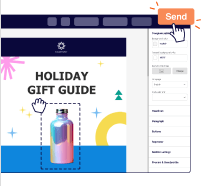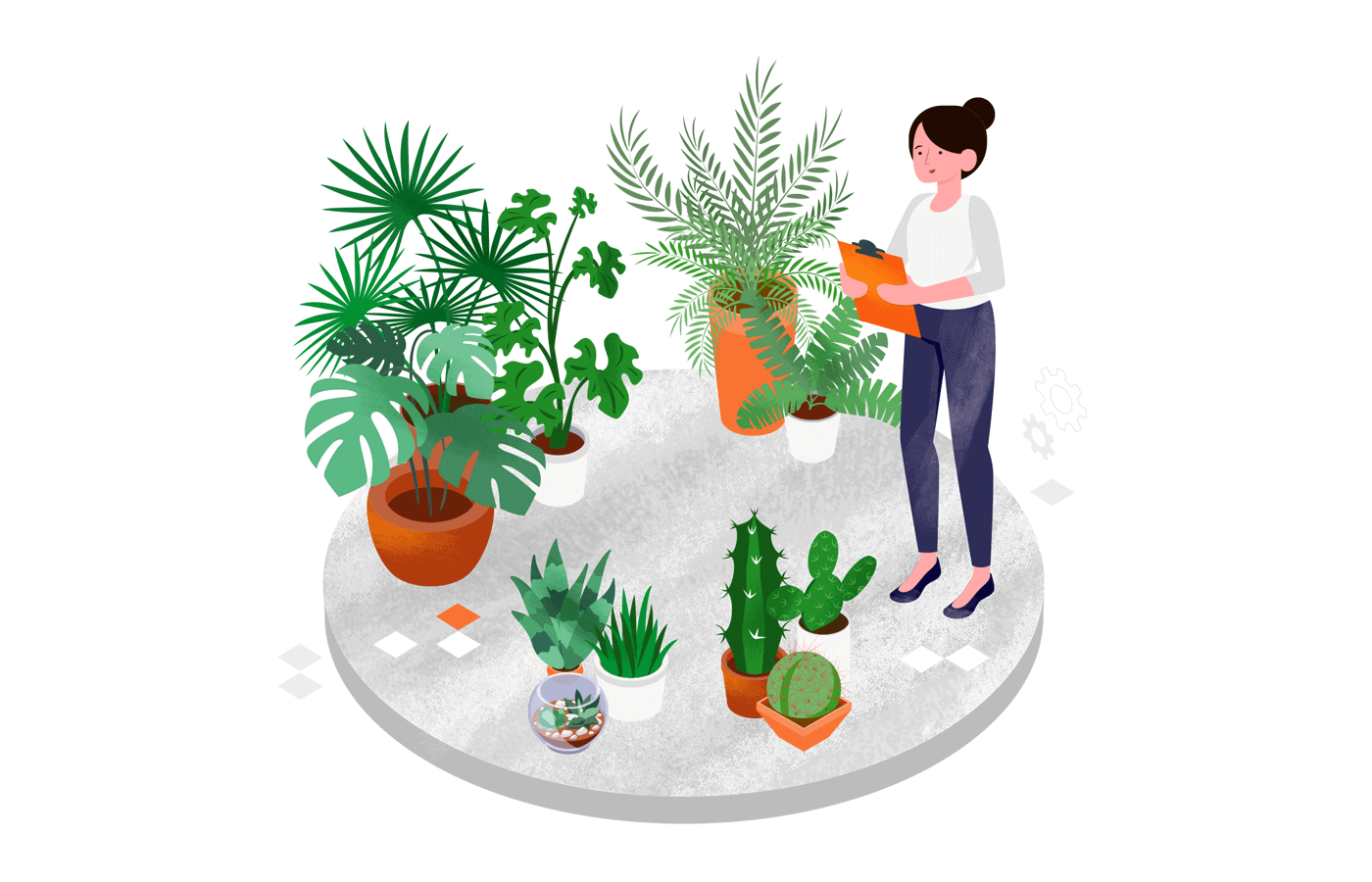Your customers come with unique personalities, preferences, and specific needs. So, it’s hardly likely that all of them will buy the same product you offer. Here’s where customer segmentation comes to help, letting you identify separate, unique customer bases and tailor your products accordingly.
Read on to learn the key points about customer segmentation and see how it’s applied in a handful of real-life examples. If you’re a beginner in customer segmentation, this post will be the perfect start for inspiration and idea generation.
What Is Customer Segmentation?
Customer segmentation divides a large group of people into smaller groups based on specific characteristics or interests. It involves grouping individuals with similar beliefs, interests, or something else into a segment.
Segmentation is an effective marketing technique that helps you personalize your marketing campaigns. With strategic segmentation, you can reach your target audience with personalized offers, messaging, or products, which is critical to modern customers.
In fact, 71% of consumers expect personalization from brands and are more likely to buy from a brand that offers personalized experiences.
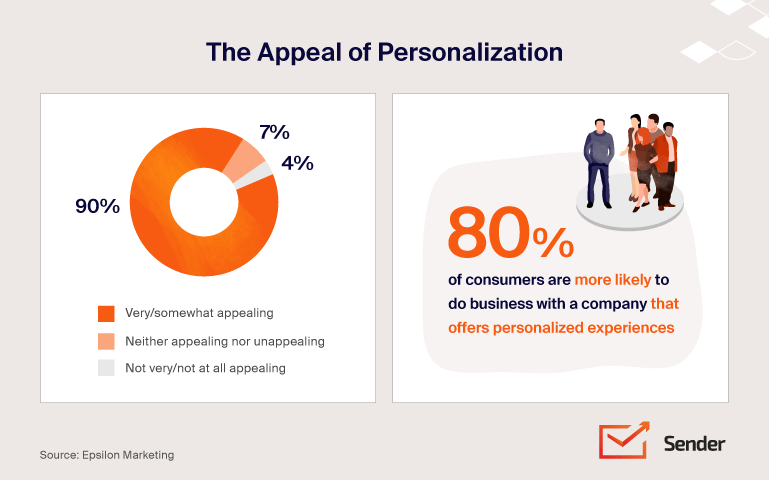
Customer segmentation allows brands to identify customers more likely to respond well to a particular marketing campaign or offer. The goal is to become relevant, personalize your offer, and increase ROI from marketing initiatives by:
- Identifying your core target audience;
- Finding common traits or ways to identify differentiated segments;
- Dividing the audience in the form of segmented lists;
- Building personalized marketing campaigns and content;
- Automating targeted campaigns and result analysis.
Customer segmentation effectively reaches the right audience with the right message at the right time. For example, you’re likely to convert a visitor who abandoned their cart through a personalized email offering an exclusive discount.
Many brands create customer segments to increase revenue from their advertising and marketing strategies. You’re probably wondering how to segment customers, what is a segment, and how it impacts the bottom line.
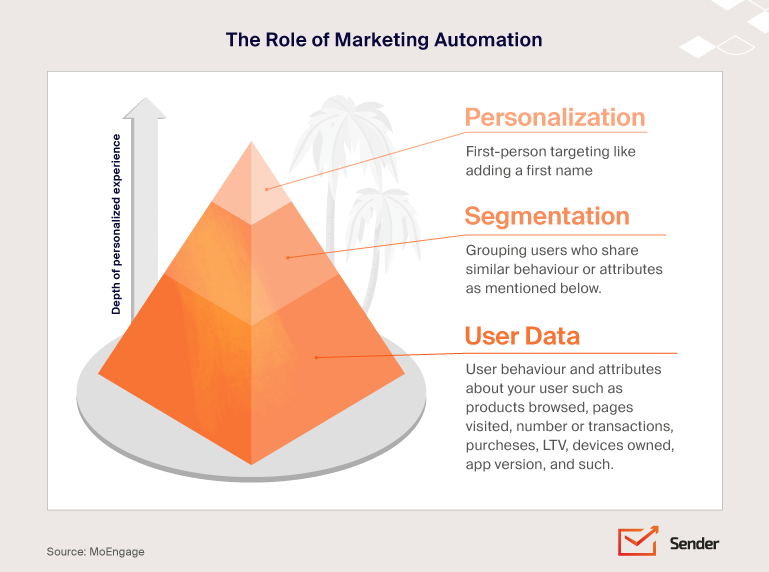
The thing is — a strategic customer segment enables you to become more relevant, helpful, and interesting to a potential customer, making your communication more personal, like a one-to-one conversation. That’s why customer segmentation is important for standing out in a competitive ecosystem.
Customer Segmentation Vs. Market Segmentation
If you’ve searched online about what is segmentation in marketing, you must have come across the terms market segmentation and customer segmentation. While you might feel that both are the same, there are some significant differences.
Customer segmentation divides customers based on demography, behavior, psychography, etc. It helps make marketing relevant, engages customers better, and leads to customer delight.
On the other hand, market segmentation is about segmenting the entire target market. It relies on macro-level data that define the whole country or region.
Customer Segmentation Vs. Market Segmentation
| Customer Segmentation | Market Segmentation | |
| Scope | Divides your existing and potential customers | Divides the entire market, region or area or operations |
| Criterion | Segments users based on demography, behavior, psychography, etc. | Categorizes the market based on macro-level economic data. |
| Benefits | Gives more granular-level data to improve marketing campaigns | Gives an idea about the general profile of your customers and your relative position compared to competitors |
| Useful for | Personalizing marketing campaigns and brand offers | Conducting market research |
Benefits of Customer Segmentation
Segmenting your customers helps you target your audience more accurately. You can target them based on their behavior and purchase patterns. This helps you personalize your campaigns to make them more appealing and optimizes your marketing funnel. Here’s why you should think of customer segmentation more seriously in 2022:
Highly-Effective Marketing Campaigns
Unique customer segments allow you to communicate with your customers in a manner that’s aligned with their hopes, expectations, internal drives, and interests.
Once you segment your audience, you know what ‘clicks’ with your audience meaning you can target them through automated drip emails or personalized marketing campaigns. This makes them feel more appreciated, increasing customer engagement and conversion rates.
Increased Customer Retention Rates
When you segment your target audience based on shared traits, it is easier for you to build relationships and provide the right value for them. Segmentation helps you create a highly-relevant unique value proposition suited to the customer’s needs and pain points.
A relevant offer directly impacts their buying behavior. They’re more likely to buy, keep coming back, and even recommend you to their friends and family.
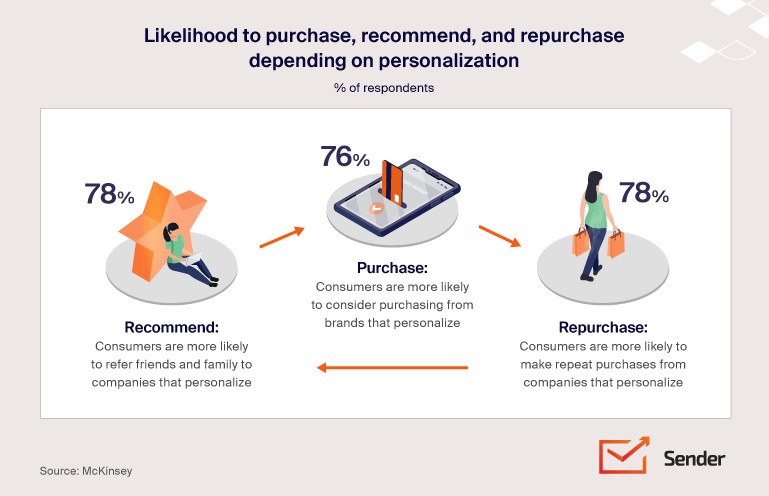
More Efficient Spending
Customer segmentation is a classification tactic that helps you increase the efficiency of your marketing spending by weeding out ineffective marketing channels. Your marketing campaigns become more specific and target prospects where they’re most likely to engage or buy from you.
Segmenting your customers saves money on mass-market campaigns by prioritizing the most effective channels. Instead of marketing across channels, you know exactly who your customers are, where they spend most of their time, and what matters to them. So you can allocate your funds strategically.
Higher Lead Quality
Targeting people most likely to buy from you optimizes your lead gen efforts. You know what drives action or engagement and receive more interest from marketing-qualified leads. These leads are your exact target audience, ready to listen to you, interested in closing faster and enhancing sales productivity.
Segment your audience based on various conditions with Sender – it’s simple:
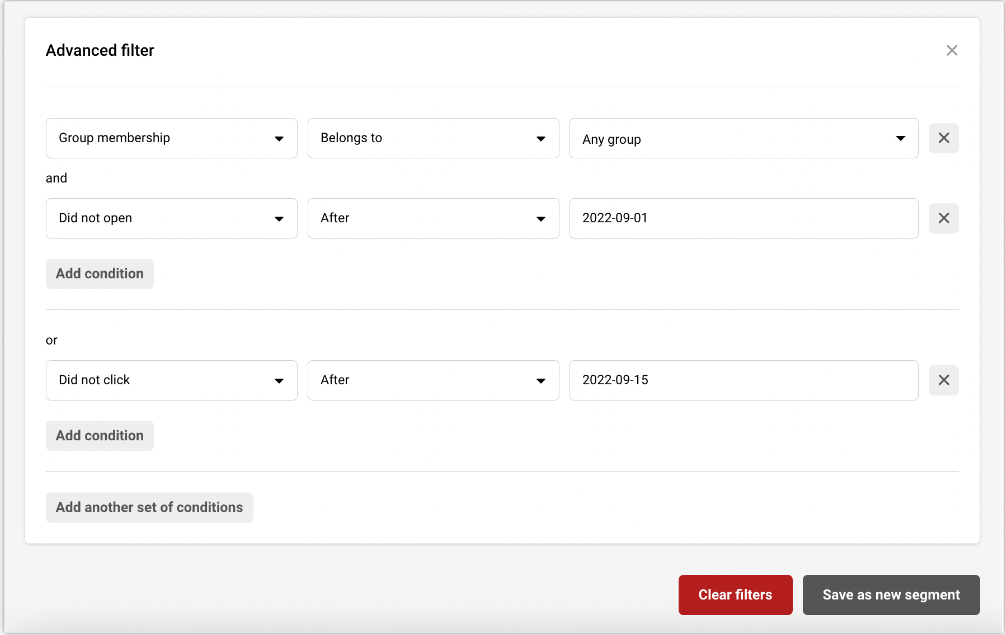
Types of Customer Segmentation
There are numerous separate factors to segment your customers by. But all in all, customer segmentation falls into two types – based on who they are and what they do. So let’s take a look at each:
Segmentation Based on Customer Characteristics
Understanding who your customers are usually involves demographics, geographics, and psychographics, while the B2B sector also looks at firmographics. This includes elements such as:
- Age;
- Residing location;
- Social status;
- Family status;
- Income;
- Personality characteristics,
- Mobile, desktop, software and application use, etc.
Segmentation Based on Customer Behavior
This type of segmentation focuses on behavioral tendencies, e.g., you can group customers based on how much they spend on a product of a particular brand (share of wallet), how often, and what products (a good indicator for spending increase).
Customer behavior will most likely be diverse, so you should single out the following in your data analysis:
- Share of wallet;
- Tenure (time spent with you);
- Basket size;
- Long-term loyalty (share of wallet and tenure combined)
Customer Segmentation Models
The customer segmentation types can be further broken down into models (specific segments based on particular features). Let’s look at the different ways you can segment your customers:
Psychographic Segmentation
Psychographics refers to the psychological traits that influence a person’s thoughts, feelings, and attitudes toward a product or service.
Psychographic segmentation is conducted based on how a person thinks and what they want to be in their life. There are five major variables for psychographic segmentation, namely:
- Personality;
- Lifestyle;
- Social Status;
- Attitude;
- Values;
- Activities, Interests & Opinions.
Marketers use surveys and direct interactions to gather data around these variables. Then use the data to discover reasons or patterns that affect a person’s buying decisions. This data may include needs, interests, lifestyle, internal drives and motivations, and subconscious traits hidden deep inside their personality.
Psychographic segmentation is often used for targeting audiences with highly-specific and intricately-tailored messages, offers, or promotions, like the one below by North Face.

North Face used ‘active lifestyle’ as a criterion to segment its audience. Using active imagery that appeals to a person who’s a traveler, hiker, or athlete in their video ad campaign, they created a highly relevant campaign that appeals directly to their audience.
Geographic Segmentation
Geographic segmentation involves dividing customers based on where they live. Geographical segmentation lets you target prospects in specific regions, so they receive customized messages and offers based on where they live.
Large retail or multi-location chain stores use geographical segmentation to tailor messages that suit local market demand or promote location-specific offers. They segment their list geographically and run campaigns encouraging people to visit their stores, grab an offer, or announce new collections locally.
McDonald’s marketing campaigns are an excellent example of geographic segmentation. Everything, from emails to TV ads, and billboards to online banners, is localized based on the country they’re advertising in.
For example, they changed their most popular product — Big Mac, into Maharaja Mac (without beef) to appeal to Indian customers. Their marketing also reflects this important aspect.
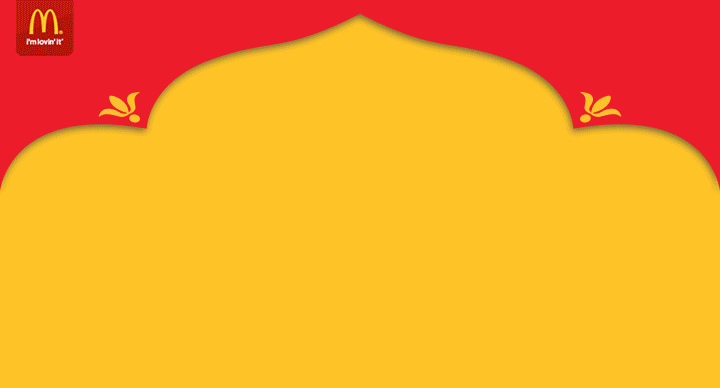
They use the local language in Japan and change their offerings according to the season — TeriTama Burger in springtime and Tsukimi Burger in autumn.

Behavioral Segmentation
Behavioral segmentation is a form of dynamic segmentation tactic that focuses on how a customer behaves online and their activity level through the customer funnel. Instead of using fixed variables, it uses data to group customers based on their interactions on your website or engagement with your email campaign.
For example, Pulp & Press segmented users who had been checking out one specific product on their website and sent an auto-responder email to nudge them to try the product in the following email.
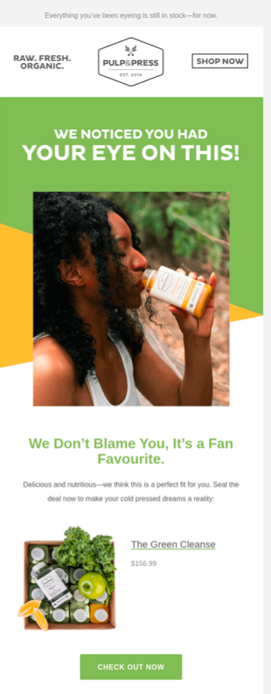
You can segment customers based on the pages they visit, the products and services they desire, what they search for on your online shop, or how they interact with elements on your website. Then you can use the specific segments to create and deliver contextual offers, recommended products, and services to the particular segment.
For example, set up the automated flows that trigger whenever someone abandons their cart. This will automatically send cart abandonment emails or text messages to your customers as a reminder to check out.
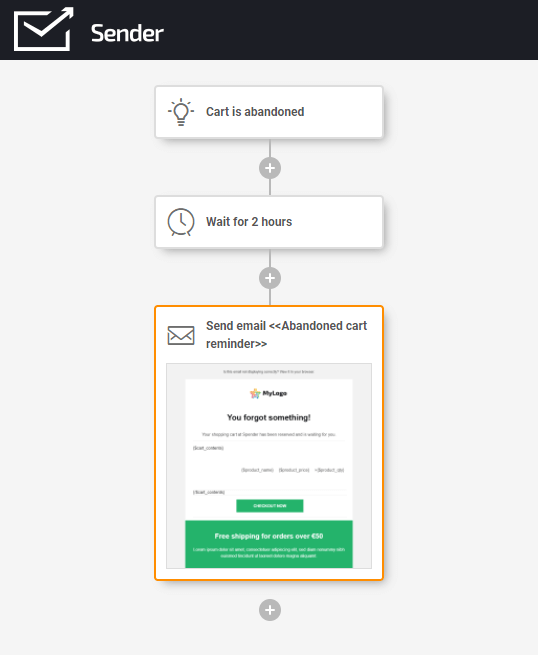
It’s easy, quick, and very effective. Oh, and you can do it with free plan, too!
Demographic Segmentation
Demographic segmentation is one of the most common types of customer segmentation. It divides customers by demographic characteristics and personal information such as age, location, income, education, gender, job, religion, etc.
Demographic segmentation is useful in industries where information like income data is helpful for lead qualification, like checking if a person is eligible for a loan offer. Marketers ask for demographic information when users sign up for an offer or newsletter and then use the information to send helpful information or offers.
For example, Babylist’s email below is targeted to empathize with Americans from a specific ethnicity during the Black Lives Matter movement.
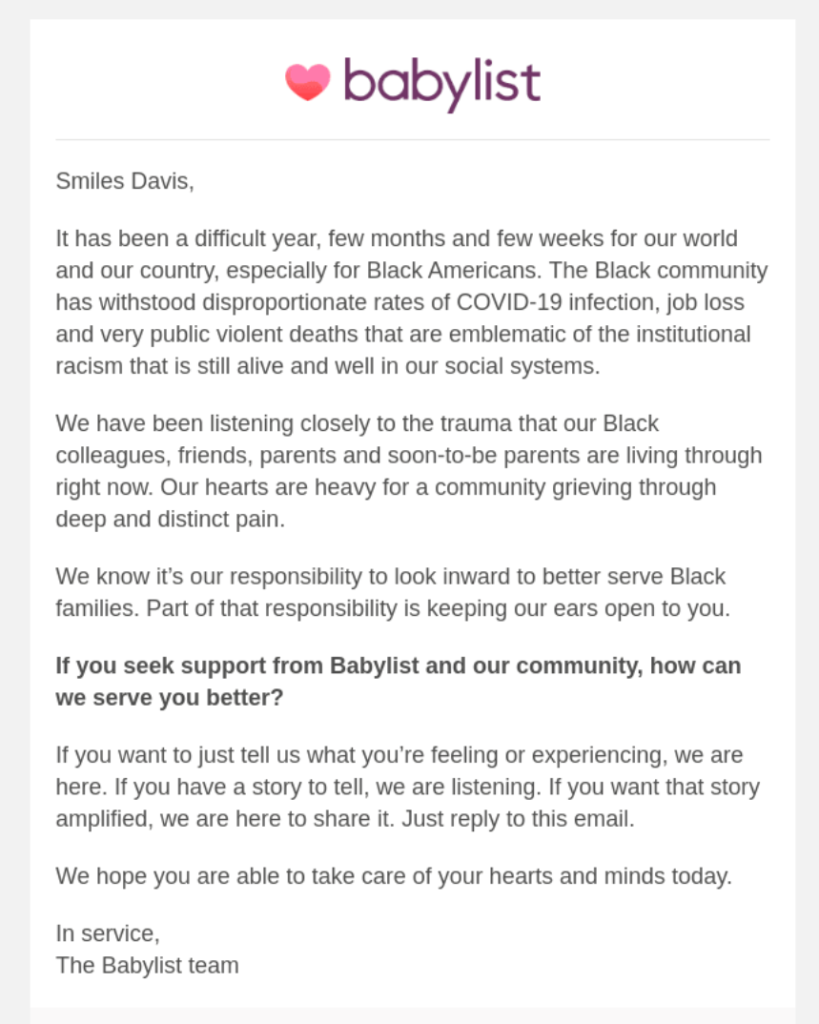
They also shared helpful information, resources, guides, and tips along with the email to help users deal with the situation, showing empathy to the target audience.
Technographic Segmentation
Technographic segmentation divides users based on their technical preferences. It categorizes users based on one or more of the following attributes:
- Browser they’re using;
- Operating system they’re on;
- Screen resolution of their device;
- Browser version;
- Mobile OS version.
As a marketer, it’s a good idea to understand where your customers find you online and segment accordingly. This helps you know their preferences and craft engaging online experiences for different channels, platforms, devices or operating systems.
Outdoorsy sending an email announcing its iOS application to its users is an excellent example of using technographic segmentation to engage iOS users.

Value-Based Segmentation
Value-based segmentation is another approach to segmenting your audience based on a particular numeric or economic value.
Businesses segment their users based on the number of purchases they made in a particular period, the average purchase value, customer satisfaction or net promoter score. Some even use it to offer onboarding assistance to users based on where they’re stuck.
Such segmentation is crucial to target users based on their position in the consumer lifecycle and even nurture leads.
For example, customers who rate a product or service negatively can be nurtured to try the product again via a personalized email that gives them a coupon code to try the service for free next time.
Firmographic Segmentation
Firmographic segmentation is an extension of demographic segmentation focusing on the company instead of the individual. It’s a standard segmentation method used in the B2B industry and groups customers based on a typical business characteristic, such as industry, type of firm, market size, the status of the company, etc.
Firmographic segmentation can happen based on any of the following parameters:
- Industry;
- Annual revenue;
- Company size
- Location;
- Sales cycle.
You can use firmographic segmentation to target your company’s products or services to specific industry sectors, such as agriculture, energy, fashion, construction, banking, healthcare, manufacturing, etc. You can also segment customers based on their job titles or roles within an industry.
For example, software products catering to small businesses, enterprises, or mid-market players create targeted campaigns that target individuals from a particular industry at LinkedIn.
Where Do You Get Customer Segmentation Data?
Finding data about your customers is challenging. But the good thing about researching in 2022 is that you have technology at your disposal. If we divide the ways to get hold of customer segmentation data, you have two options:
Direct or Primary Research
Direct, also known as primary research, is more suitable for existing businesses (or someone with a large budget and access to data).
Here’s what you need to know about this type of research:
- It involves conducting surveys, organizing focus groups, or using market research platforms to understand more about your customers;
- Usually, online tools, applications, and platforms are used to gather data for primary research;
- If you already have a customer base, you can use your website analytics and CRM dashboard or reach out to your customers to get data for segmentation.
Indirect or Secondary Research
Usually, ideation-stage startups rely on indirect (aka secondary) research to gather data about customers.
Let’s see what it is and how it works:
- Indirect research involves using publicly available data to gather the pulse of your audience,, e.g., googling information about who’s buying the most iPhones in the United States of America.
- It’s done early to support some hypotheses and build a customer base to get closer to the audience.
- Many tools, like Google Trends, Think with Google, Statista, etc., can help gather data about your potential customers.
Effective Customer Segmentation Strategies
You already know by now what is segment in business. Segmentation is a powerful tactic used by smart marketers and brands to win more business. Here are some examples of how you can use segmentation to grow your business.
Personalize Your Campaigns
Personalization is critical to building a loyal, engaged, and long-term customer base. Segmentation helps you personalize your offerings and communication across mediums like email and paid ads.
You should always use segmentation to personalize your messages based on customer life stage, location, interests, etc. The more personalized and targeted your emails, the better results you’ll register from a marketing campaign. See the example below from ergoPouch.
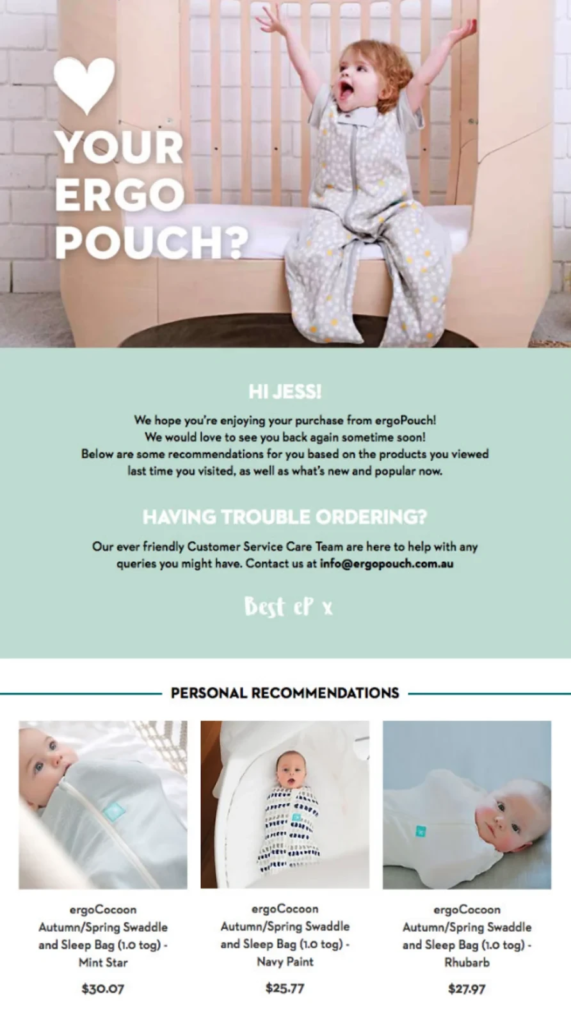
The email uses past history (behavioral data) to reengage an existing customer with personalized shopping recommendations. Notice how the brand has floated the idea of ‘enjoying last purchase’ to create an instant recall and connection.
Reengage Inactive Customers
Reengaging inactive customers increases the customer lifetime value for your business. Segmentation can help you set up automated re-engagement campaigns that prompt an inactive customer to give you another shot.
You can create a segment for users who haven’t interacted with your email or website in the past six months. Then give them a compelling reason to reengage, for example, an exclusive one-time offer to buy a product they wish listed months ago.
Noom uses a similar re-engagement strategy for customers who might have checked the website but didn’t buy anything by sending a personalized email to reactivate lost prospects.
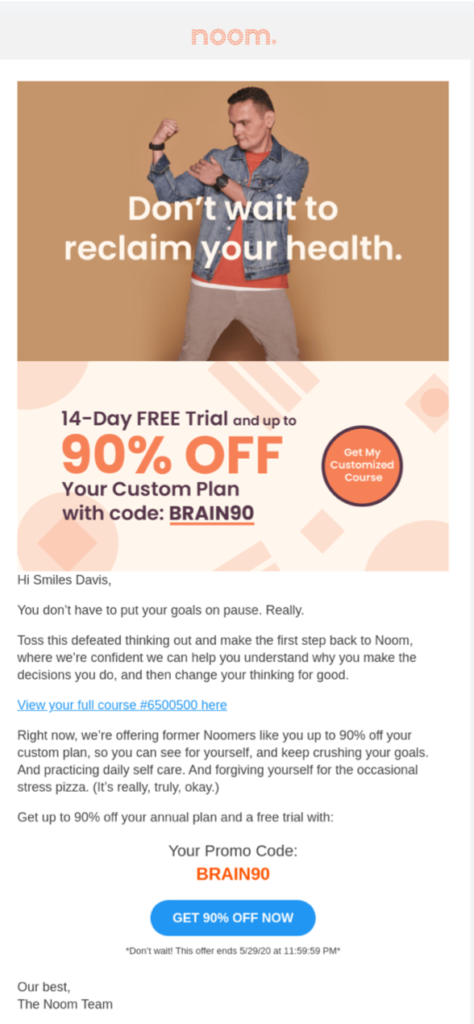
Engage New Customers
Engagement is key to the success of every email (and not only!) marketing campaign. So, if you’re not engaging new customers, you’re missing out on potential conversions.
Customers look for warmth and personalized recommendation from a brand in 2022. They want to know that you care about their data, feedback and opinion. It makes them feel valued and showcase their importance for a business.
Use an autoresponder to send new subscribers a warm and hearty welcome email. You can segment users based on the medium they found you or the offer they responded to.
For example, suppose someone came to your website looking at your Facebook ad for a gift. In that case, you should probably create a custom welcome email sharing details about redeeming the gift as Cat Caboodle does in their welcome email.
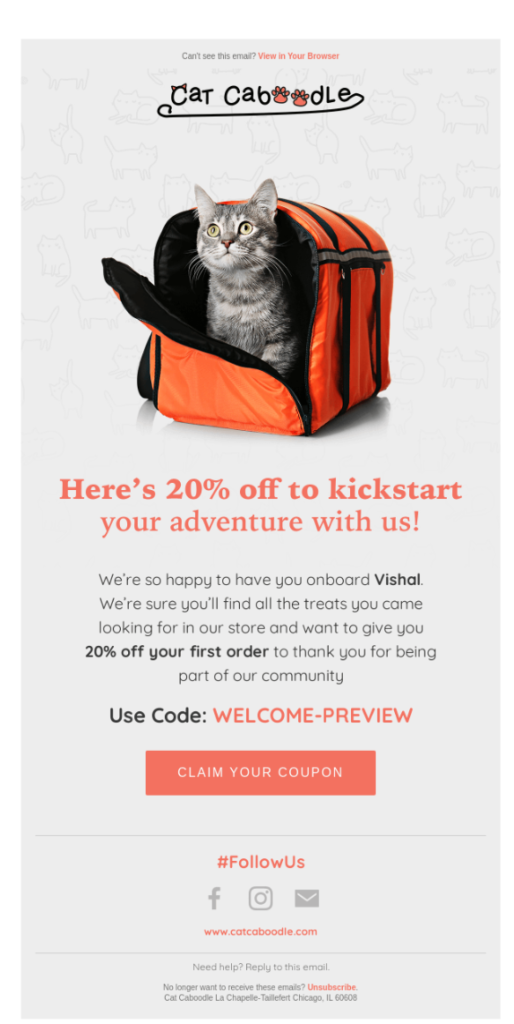
Optimize the Value of Your Customer Segments
Once you have established segments, they can help determine where you should put your marketing effort.
Use them for the customer segmentation analysis to:
- Regularly follow which of your segments are generating good revenue;
- Check the fluctuation in the number of people in each segment from time to time;
- Follow up with customers on their opinion of your marketing efforts.
For the latter one, encourage your customers and colleagues to speak out – send surveys email, include feedback options in live chats, or give them a good old call. Hear them out and use these valuable insights to optimize customer segmentation further.
Interact with Active Customers Regularly
Active customers are the ones who have visited your site multiple times in the recent past or buy from you regularly. Every business has a group of active customers who are attentive and responsive to your offers.
These people are not just loyal; they’re also your biggest advocates. Learning to appreciate and interact with this group can help your business grow phenomenally through referrals and positive word-of-mouth.
Segmenting users based on their last purchase, email engagement, website activity, or previous interactions can give you ample opportunities to keep active customers excited about your brand.
You can send them special offers appreciating their loyalty, surprise them with special gifts, or improve their shopping experience through personalized recommendations based on their purchase history.
For example, Calvin Klein does a great job at segmenting its active customers based on their shopping and browsing patterns. Then using the information to personalize its email templates with shopping recommendations and send price alerts, offers, or exclusive benefits like in the email below.

Upsell & Cross-Sell to Repeat Customers
Upselling and cross-selling are two proven techniques to increase sales revenue. You can entice repeat customers to make additional purchases by showing personal offers. To do that, use a similar product or service they may have purchased.
For example, if they buy organic snacks from you, you know they’re health-conscious and send them an email to try your herbal range of teas.
To set up cross-sell and upsell campaigns, you can segment your list based on past purchases and preferences such as:
- Customer’s purchase history;
- Customer’s purchase history in specific product categories;
- Your most valuable customers (repeat, high-value, loyal buyers).
Then you can create personalized email campaigns for the segment that automatically gets triggered every time someone completes a purchase with an exclusive offer on complementing products. Dollar Shave Club uses the same strategy to increase average order value.
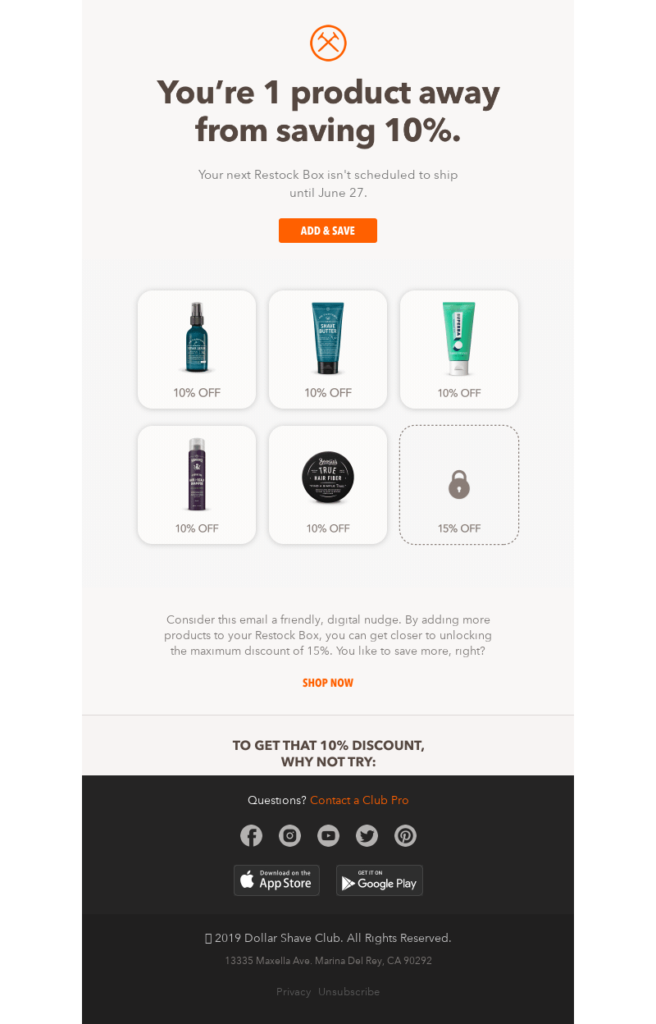
You can also use the segmented lists and automate personalized campaigns to encourage people to leave reviews, sign up for your newsletter, or share about their purchases on social media.
Cart Abandonment Emails
If you run an online shop or eCommerce store, you know how painful cart abandonment can be. It’s hard to register sales once a shopper leaves your site. That’s why it’s essential to send cart abandonment emails reminding the customer to check out.
Sender helps set up automated cart abandonment sequences for email and SMS as below:
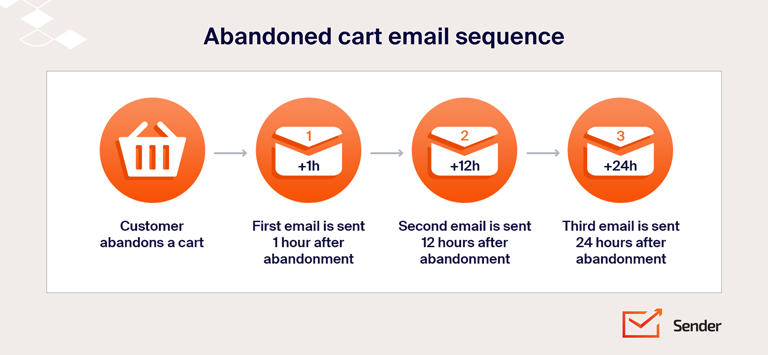
You can set up an automation sequence, create a special offer, target abandoners on your website, and see your conversions going through the roof using automated cart abandonment workflow.
Segmenting the list based on actions performed on the site, such as adding items to a cart, help set up cart abandonment emails. An email containing a unique coupon code or offer to entice customers to complete the purchase works well, like the one below by Winc.
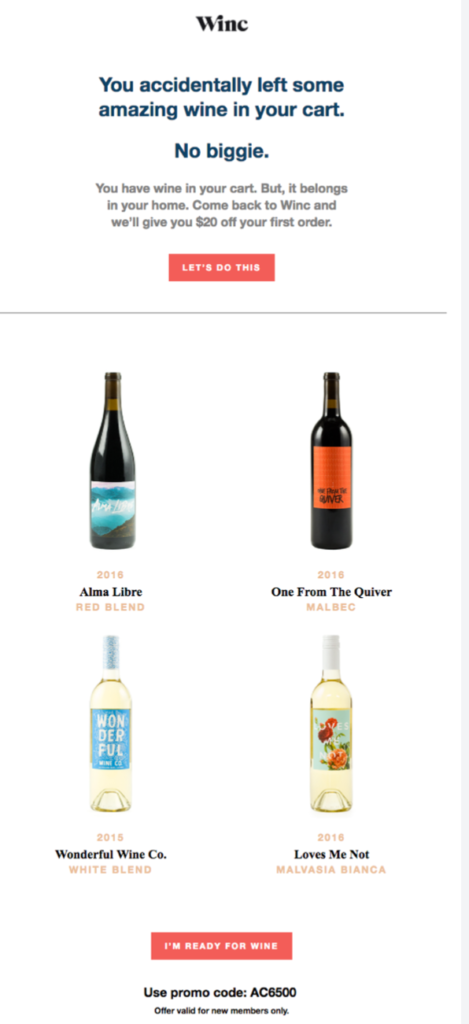
Organize Your Customer Data
Organizing your customer data into segments is one of the most effective ways to identify gaps and opportunities to improve the customer experience.
Once you have your dedicated segments based on psychography, demography, or behaviors, you can easily visualize need and opportunity gaps in reaching out to your prospects or customers. Then you can use a marketing automation tool to create highly-effective and contextual marketing campaigns to boost sales.
Target Subscribers Who Haven’t Ordered Yet
Customers who haven’t made a purchase but are on your list are like untapped opportunities. They know you, follow your brand, and are most likely to convert if you set up a strategic and personalized campaign.
It could be a simple miss you email, but you can also use more data to create a personalized offer. For example, if a customer has been on your email list for some time, opens your emails regularly but hasn’t purchased anything, you can send an exclusive gift card or coupon to convince them to try your products.
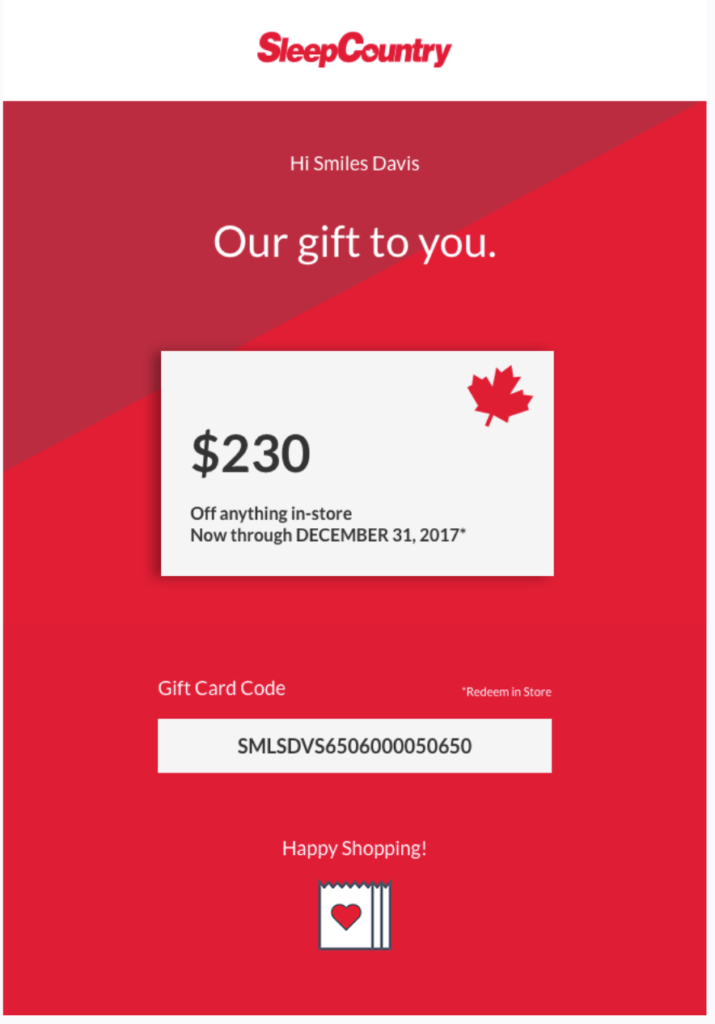
But always remember that everyone who signs up for a subscription will not be your buyer. Segmenting subscribers based on your ideal customer demography and setting up automated lead nurture campaigns is better.
Nudge Customers who Love a Specific Brand or Product
Another great way to leverage personalization benefits is clustering target customers based on their product preferences.
For example, set up automation triggers that divide users based on product categories or brands they buy. Or you can even divide users based on the pages/collections most visited by a user.
Then you can segment them into a specific list and set up nurture campaigns to entice them to buy their favorite products.
The following email from Cole Haan is a great example of contextual targeting.
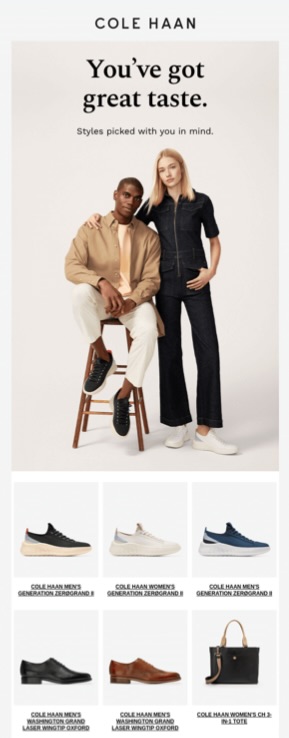
The email shows the complete range that the user has been eyeing with a CTA to explore more designs. Such a contextual brand outreach has a high chance of conversion.
Customer Segmentation Software to Help You Use Customer Segmentation Strategy
Your mind must be brimming with ideas to segment your customers by now. Technology and SaaS tools allow you to leverage data science, follow simple steps, and speed up the segmentation process. This way, you can leverage personalization’s benefits across all your marketing campaigns without deep learning or heavy lifting.
A customer segmentation tool helps you organize your customers into segmented lists, management of static as well as dynamic segments, and automate marketing campaigns. Ideally, a customer segmentation tool should pull data from multiple sources and automate the process of segmenting your email lists. Here are a few tools that can help you get started:
- Kissmetrics: Kissmetrics help you segment your audience based on online behavior, demography, and more by connecting to your website. You can use the customer segments to set up email campaigns, personalize your landing pages, and more.
- Baremetrics: Baremetrics customer segmentation features allow you to visualize your audience segments on a central dashboard. You can track real-time data from multiple sources and set up segments quickly to maintain the freshness of your email list.
- Google Analytics: Yes, Google Analytics can also help you get started with audience segmentation. You can use your existing online traffic to find user insights, track their online activity, and set up segments to categorize your online customer base.
- Optimove: Optimove aims to improve customer engagement, retention, and lifetime value by helping you target customers throughout the entire customer lifecycle. With automated tools that facilitate management of personalized marketing campaigns, Optimove becomes an excellent option if you’re targeting the B2B segment.
Also read: STP Marketing: Segmentation, Targeting, Positioning Model
How to Do Customer Segmentation For Email Marketing?
One of customer segmentation’s most rewarding use cases is to power your email marketing strategy using client data. You can use customer insights to personalize your email templates, optimize your marketing campaigns, improve engagement, and drive sales.
Sender helps you leverage the benefits of segmentation through advanced features such as email list segmentation and automated campaign flows.
You can segment your customers into specific groups or add custom fields for personalizing your email campaigns. Here’s why you should think about using Sender:
- Set up custom segments and groups to target users contextually;
- Nurture leads through automated SMS and email marketing campaigns;
- Use easy-to-create popups & forms to generate quality leads;
- Improve customer retention rates with automated email & SMS sequences;
- Create automated upsell/cross-sell, win-back, and reactivation sequences.
Key Takeaways
You probably came here trying to understand why customer segmentation is important. Now, finally, you know that everyone’s so serious about segmenting customers because:
- Segmentation gives you foresight into what your audience wants;
- Segmentation helps add relevance and context to your marketing campaigns;
- It enables you to personalize email and SMS messages and make customers feel valued;
- Contextual segmentation paves the way for many growth opportunities like upselling and cross-selling.
Also read:
